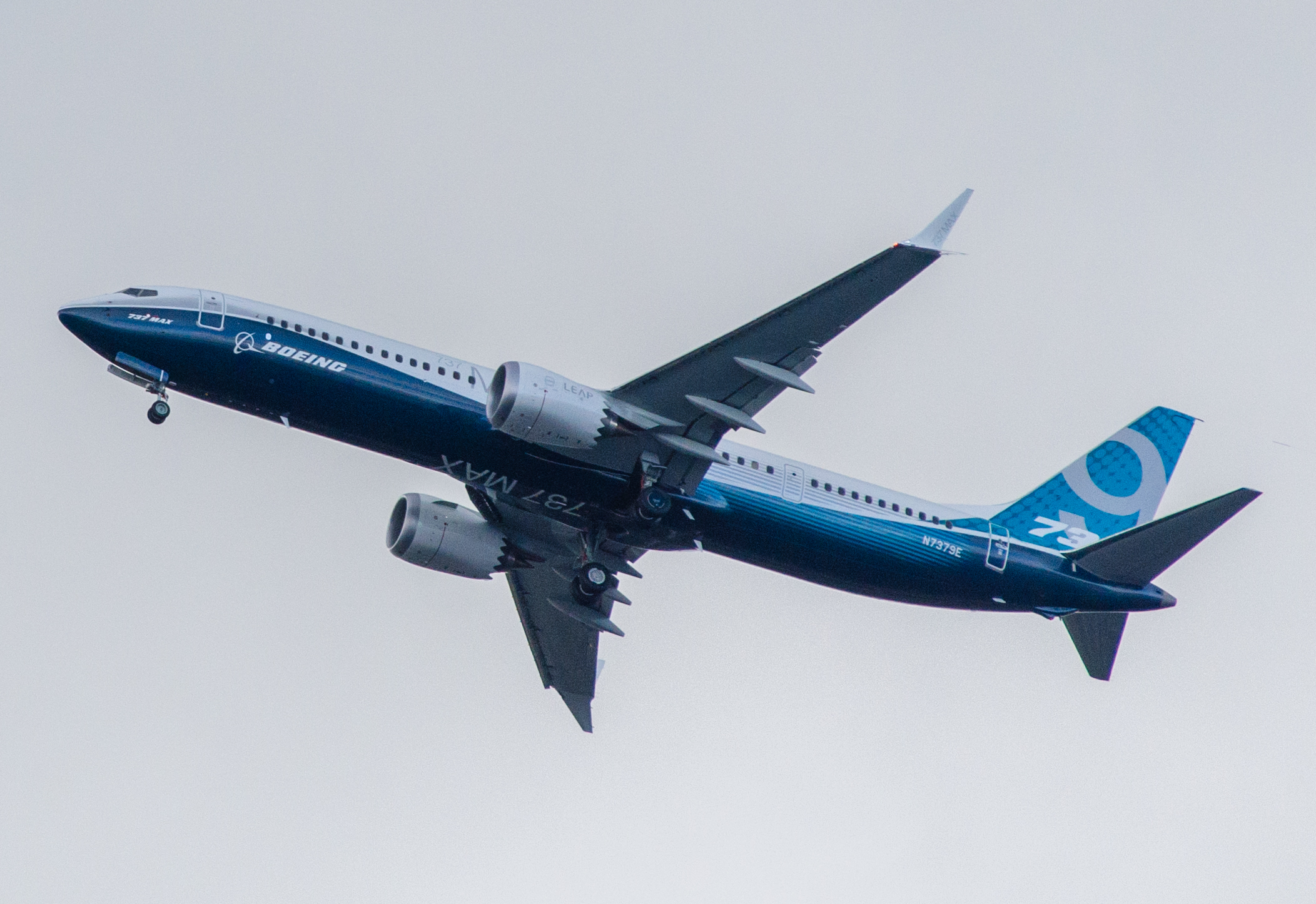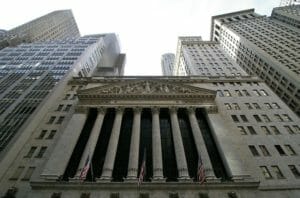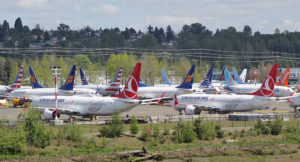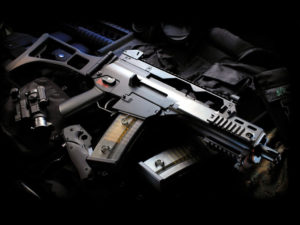Boeing Is a Perfect Parable for 21st-Century Capitalism
The onetime standard-bearer for civil aviation has sacrificed a viable business model and basic safety concerns at the altar of greed. Wikipedia
Wikipedia
A veteran commercial pilot and software engineer with over three decades of experience has just written the most damning account of the recent Boeing 737 fiasco. At one level, author Gregory Travis has provided us with the most detailed account of why a particular plane model once synonymous with reliability became a techno-death trap. But ultimately, his story is a parable of all that is wrong with 21st-century capitalism; Boeing has become a company that embodies all of its worst pathologies. It has a totally unsustainable business model—one that has persistently ignored the risks of excessive offshoring, the pitfalls of divorcing engineering from the basic R&D function, the perils of “demodularization,” and the perverse incentives of “shareholder capitalism,” whereby basic safety concerns have repeatedly been sacrificed at the altar of greed. It’s also a devastating takedown of a company that once represented the apex of civilian aviation, whose dominance has been steadily eroded as it has increased its toxic ties to the U.S. military. In that sense it mirrors the decline of America as a manufacturing superpower. And finally, it shows a company displaying a complete loss of human perspective in the “man vs. machine” debate.
Here’s the crux of Travis’s analysis: “Design shortcuts” led to safety hazards. The newest version of Boeing’s 737 plane, previously known for its reliability and ease of use, became a high-tech disaster. Machines overwhelmed man. And worst of all, the aviation industry regulatory overseer, the Federal Aviation Administration (FAA), subcontracted the safety/certification functions to Boeing itself, so there was no early warning system in place to avert the resultant tragedy.
Travis largely restricts his analysis to the 737. But his article illustrates pathologies long evident at Boeing and the FAA.
Let’s look at the last problem first: The FAA suffers from reduced funding from Congress (the Daily Beast reported that “the agency’s 2019 budget actually cut funding for the Aviation Safety Office by 1.7 percent”), and a corresponding loss of aviation expertise, as many of its top personnel have migrated to the private sector. Of course, that’s nothing new for the FAA, which has a sad history of hemorrhaging personnel since the days of the air traffic controllers’ strike/collective dismissal under Reagan (a cost control measure), as well as embracing neoliberal, supposedly market-based performance incentives that are thoroughly inappropriate for a regulatory body first and foremost responsible for flight safety.
Becoming more “industry-friendly” and starved of adequate personnel and fiscal resources to do its job properly, the FAA has therefore been forced to delegate much of its regulatory oversight and certification functions to the airline industry itself (“self-certification”) and has therefore become a case study in “regulatory capture.”
Boeing’s failures resonate with the public in a way that no complicated financial fraud possibly could. It takes a certain level of technical expertise to understand how the toxicity of a financial derivative poses dangers to an economic system; but everybody instinctively understands the tragic impact of a plane crash, like the doomed Lion Air and Ethiopian Airlines 737-related accidents.
The seeds of Boeing’s destruction arguably were planted well before the 737-related mishaps. The warning signs were already evident in the 787 Dreamliner program a decade ago, which even today continues to be characterized by repeated engine design flaws and cost overruns. In a Harvard Business Review article, Professors Gary Pisano and Willy Shih first highlighted the perils of Boeing’s embrace of “demodularization”: “[T]he shift from aluminum alloys to carbon-fiber-composite materials changed things. The old modular design rules could not fully account for stress transmission and loading at the system level—something that Boeing did not get right initially.”
Boeing couldn’t get it right because the company had shifted large chunks of its design and manufacturing facilities to disparate parts around the globe—too far apart geographically, in fact, to monitor everything properly: “As a result it encountered problems assembling the pieces (such as the horizontal stabilizer from Alenia Aeronautica in Italy and the wing box from Mitsubishi Heavy Industries in Japan). Significant redesign and rework were required, and the program suffered major delays,” write Pisano and Shih.
With one part of the plane being manufactured in Italy, and another in Japan, management was unable to assess quickly the resultant design and engineering flaws before launch. Even after the initial launch delays were addressed, Dreamliner’s history has been characterized by repeated recalls and cost overruns.
Offshoring, of course, is nothing new. In our brave new world of globalized capitalism, multinational corporations like Boeing are constantly on the lookout for global labor arbitrage possibilities, which have the happy effect of curbing unit labor costs, fattening profit margins, and thereby juicing the company stock price (an increasingly important part of management compensation, irrespective of the underlying performance of the company itself in the real world). These are all part and parcel of the pathologies inherent in America’s increasingly financialized “shareholder capitalism” (see here for more details).
But Boeing’s problems extend beyond that. It is a company that has historically been very successful in the highly competitive civil aviation market since the 747 jumbo jet (“the Queen of the skies”) first dominated some 50 years ago. The 21st century has been less kind to the company, however, as its failures have been increasingly exacerbated by its growing, and increasingly toxic, ties to the U.S. defense industry.
These links began in the late 1990s when the U.S. Department of Defense helped to engineer a merger of Boeing and McDonnell Douglas, the latter an important supplier of combat aircraft to the United States. Far from being the “largest, strongest, broadest, most admired aerospace corporation in the world,” as promised at the time of the merger by John McDonnell, chairman of McDonnell Douglas, the corrupting practices of the Pentagon soon began to infect the newly combined entity. In particular, the 787’s outsourcing strategy turned out to be a fiasco, which even then-Boeing CEO Jim Albaugh was forced to concede in a Seattle Times report.
But the Seattle Times also exposed that the rot took hold well before the 787 debacle, citing an internal Boeing Report, written in 2001 by Dr. L.J. Hart-Smith, a mere five years after the merger was consummated. Hart-Smith described the disastrous economic effects of excessive outsourcing that began to afflict Boeing almost immediately, especially as its ties to the military expanded. These problems are elaborated here by longtime defense analysts Franklin “Chuck” Spinney and Pierre Sprey:
“The so-called spin-offs offs from Defense spending can transmit the corrupting effects of the politically motivated, cost-plus economics of the Military – Industrial – Congressional Complex (MICC) into the larger economy[.] The MICC not only subsidizes wasteful cost growth in the Pentagon, its activities infect the overall economy by soaking up scarce investment and human capital; corrupting the practices of science and engineering; distorting research content on a huge scale; while providing incentives for inefficient production and management practices, (e.g. excessive outsourcing for political reasons – aka the political engineering practices explained here and here), not to mention the politicizing of industrial management.”
Contact with the Pentagon often signals death for a civilian company because of the incentives inherent in its “cost-plus” contracts, along with the geographic disbursement of manufacturing facilities to as many parts of the country as possible in order to maximize congressional political support for increasingly expensive military boondoggles—what Spinney and Sprey term “political engineering.” These two factors bias corporate practices toward inflating costs and therefore foster waste and diminish safety. By contrast, in a traditional civilian model, profit margins are best secured by reducing costs as much as possible in order to maximize the bottom line.
As Boeing’s ties to the military increased, so too did its shoddy corporate practices. The 787 Dreamliner is still plagued with production problems, and there is little sign that Boeing has rectified them. The company has failed to reintegrate basic manufacturing and R&D to correct the original problems highlighted by Shih and Pisano (quite the contrary, as the company is increasingly shifting production to China in order to safeguard its market share there). Just this month, the New York Times has reported that “the [Charleston, South Carolina-based] factory, which makes the 787 Dreamliner, has been plagued by shoddy production and weak oversight that have threatened to compromise safety.” A former quality manager, John Barnett, a whistleblower who worked at Boeing for nearly three decades, damningly suggested to the New York Times: “I haven’t seen a plane out of Charleston yet that I’d put my name on saying it’s safe and airworthy.” Recall that Boeing originally moved some of its operations to the “right to work” state of South Carolina to undermine the strength of its unionized workforce in the state of Washington, which has had an adverse effect on the overall quality of its products.
That’s on top of the recent 737 debacle, where Boeing evidently missed safety risks in the design of the newer model, “like an anti-stall system that played a role in both crashes,” as the same New York Times article noted. But the genesis of the problem of the 737, a plane Gregory Travis (a pilot of 30 years’ standing and a software engineer of 40 years’ experience) writes was once known for its “reliability” and relative technological “simplicity,” lay in the fact that “market and technological forces pushed the 737 into ever-larger versions with increasing electronic and mechanical complexity.”
The main problem, notes Travis, was the engine redesign. The engine’s size was increased to enhance the 737’s overall energy efficiency, but it became too large to be accommodated in its traditional spot on the plane. The expansion ultimately necessitated extending the engine up and well in front of the wing. That changed the relationship between engine’s “thrust” and its center of gravity, which, in the words of Travis, caused the 737 “to ‘pitch up,’ or raise its nose… a bit too much for comfort on power application as well as at already-high angles of attack. It violated that most ancient of aviation canons and probably violated the certification criteria of the U.S. Federal Aviation Administration.”
“Angle of attack,” as Travis defines, refers to the angle between the wing and the relative wind blowing over it. The more a pilot lifts the nose of the airplane, the higher the angle of attack and the more the lift of the wing increases—until you reach the stall limit angle of attack, when suddenly the wing stops lifting entirely (because the relative wind’s smooth airflow over the wing has separated catastrophically from the wing surface). That’s why an airplane that adds extra “pitch up” force to the nose when the pilot commands just a slight increase in angle of attack (that is, in nose up angle) is so dangerously unstable—because it can lead to a fatal stall situation that likely was the cause of the two crashes.
Egregious violations to basic aerodynamic principles should have induced the FAA to step in and force a redesign of the Boeing’s latest incarnation of the 737 (the so-called “Max 8”) in order to minimize the safety risk. But there were two problems:
- Making the required hardware modifications would have been hugely expensive (to the point where Boeing would have had to build an entirely new aircraft, rather than merely modifying a popular, hitherto safe and easy-to-fly airplane)
- As noted above, the FAA was already overwhelmed, and consequently was beginning to allow Boeing to “self-certify” its own planes.
Rather than design a whole new plane the “solution” to point 1 was the installation of yet more software, in this case the “Maneuvering Characteristics Augmentation System,” or MCAS, for short. The goal, writes Travis, was to enable the computers to push “the nose of the plane down when the system thinks the plane might exceed its angle-of-attack limits; it does so to avoid an aerodynamic stall. Boeing put MCAS into the 737 Max because the larger engines and their placement make a stall more likely in a 737 Max than in previous 737 models.” Unfortunately, the MCAS software “solution” was a totally incompetent, unsafe Band-Aid that used the computer to counter (or perhaps more correctly, to mask) the airplane’s dangerous tendency to lift the nose too much and get the stall situation where the computer takes over from the pilot to resolve a problem that initially stemmed from a hardware issue.
As far as point 2 goes, as Travis describes it:
“As airplanes became more complex and the gulf between what the FAA could pay and what an aircraft manufacturer could pay grew larger, more and more of those engineers migrated from the public to the private sector. Soon the FAA had no in-house ability to determine if a particular airplane’s design and manufacture were safe. So the FAA said to the airplane manufacturers, ‘Why don’t you just have your people tell us if your designs are safe?’”
You can immediately spot the parallels between the 2008 global financial crisis and the Boeing crashes. Much like the FAA with Boeing, in 2008, our global monetary authorities, regulators and ratings agencies were starved of adequate resources and expertise to properly scrutinize the activities of Wall Street’s financial engineers. They were forced to accept at face value the banks’ mathematically unsound “value at risk” models to justify the soundness and fundamental safety of their newly created derivatives on the lines that the underlying asset pricing followed a “normal” distribution pattern. Of course, these derivatives did no such thing, because the price history was inadequate to establish a truly normal pattern; therefore, the math on which risk management was predicated turned out to be flawed with catastrophic consequences, as former Fed Chairman Alan Greenspan ultimately acknowledged.
Similarly, the MCAS software “solution” that was supposed to “fix” the engineering problem of the new 737 failed, because it was based on a flawed paradigm: no computer software can fundamentally repudiate the principles of aerodynamics. And in both cases, the regulatory capture and inadequate financial resources accorded to the authority precluded it from stepping in before disaster struck. Hence, the FAA did not once highlight the risks of the new anti-stall system when it certified the “new and improved” 737 Max 8 as airworthy some two years ago, according to the Washington Post. This is because Boeing had already attested to the plane’s fundamental fly-worthiness (much as Wall Street’s models minimized the possibility of a “black swan” discontinuity in the financial markets, which induced the relevant compliance bodies to green light them).
Consequently, both Boeing and a multitude of financial institutions post-2008 suffered “crashes.” Note as well in each case how increasing complexity becomes the enemy of effective regulation and, ultimately, safety considerations themselves. In both cases, they ignored what Travis and others call the KISS principle: “Keep it simple, stupid.”
There’s another interesting dimension to this Boeing calamity, which points to the perpetual “man vs. machine” debate that has been the story of capitalism since the days of the Luddites. Contrary to popular characterization, the Luddites were not simply technophobes, beating back the forces of progress. They were highly skilled artisans, protesting the fact that their livelihood was being displaced by automation, imposed on and displacing them like expendable commodities with virtually no consultation from the business owners themselves.
Likewise, in the new Max 8 plane, the new MCAS software was introduced without letting the pilots know about its main features. The key characteristic of MCAS is that it is activated without the pilots’ input. Worse still, according to the Verge, “both jets that crashed lacked safety features that could have provided crucial information to the crew because they were sold as options by Boeing, according to the New York Times.”
A huge failing of MCAS is that it effectively eliminates the human “feel” dimension to flying, as Travis illustrates:
“In the old days, when cables connected the pilot’s controls to the flying surfaces, you had to pull up, hard, if the airplane was trimmed to descend. You had to push, hard, if the airplane was trimmed to ascend. With computer oversight there is a loss of natural sense in the controls. In the 737 Max, there is no real ‘natural feel’…
“There is only an artificial feel, a feeling that the computer wants the pilots to feel. And sometimes, it doesn’t feel so great.
“When the flight computer trims the airplane to descend, because the MCAS system thinks it’s about to stall, a set of motors and jacks push the pilot’s control columns forward. It turns out that the flight management computer can put a lot of force into that column—indeed, so much force that a human pilot can quickly become exhausted trying to pull the column back, trying to tell the computer that this really, really should not be happening.” (Emphasis added.)
The MCAS computer software taxes a pilot beyond his physical capacities. And while it is true that in modern long haul commercial flying, computers do most of the actual flying, redundancy is normally built into the system to enable human beings to override the software if the pilot spots a problem. What distinguishes the newly incorporated MCAS system is that it denies the pilot’s ultimate sovereignty or, as the author starkly puts it: “It denies the pilots the ability to respond to what’s before their own eyes.”
Travis ultimately evokes Kubrick’s “2001: A Space Odyssey” to indicate something of the scale of the technological dysfunction created here by Boeing: “Raise the nose, HAL.” “I’m sorry, Dave, I’m afraid I can’t do that.”
The key difference between the two situations is that in Kubrick’s masterpiece, HAL, the computer, was finally overridden by human action when circumstances necessitated and was therefore deactivated before more disaster could strike. The issue implicit in Travis’ imagery in regard to the Max 8 is that we may have taken this technophilia too far in the direction of computers to the point where today’s modern day “HAL” cannot be controlled by the pilot.
Boeing’s pathologies therefore illustrate the perils of innovation for innovation’s sake. But the company is symptomatic of a much bigger problem: We lionize the “progress” of Silicon Valley’s entrepreneurs, even as they produce self-driving cars (which cause fatal accidents), multifunctional smart phones (that threaten our privacy), high-tech drones (that bring airports to a standstill), or any kind of extreme automation in the workplace that degrades the role of human beings.
The crashes of the Boeing 737 jets ultimately reflect a hubristic faith in the power of the machine, a factor that is creating its own kind of dystopian 21st-century nightmare worthy of a Philip K. Dick novel. We view technology not as a man-made invention designed to help us, but as an autonomously fixed condition that bears little relation to human behavior. This lack of integration means that complexity overwhelms us, rather than enhances our quality of life. It commodifies us. Labor is just a cost input to be replaced, if possible, by a robot; it is no longer viewed as a source of demand. The same unthinking mentality that sees regulators as a dispensable encumbrance who clutter the operations of “the free market”; or safety is an optional feature that mustn’t be allowed to interfere with the bottom line; where the needs of employees are subsidiary to the profits of shareholders and management; and the military is prioritized over the needs of the civilian economy.
Boeing sadly embodies so much of our current economic and social dysfunction with predictably deadly consequences. But it is not alone or unique by any stretch of the imagination
This article was produced by Economy for All, a project of the Independent Media Institute.
Your support matters…Independent journalism is under threat and overshadowed by heavily funded mainstream media.
You can help level the playing field. Become a member.
Your tax-deductible contribution keeps us digging beneath the headlines to give you thought-provoking, investigative reporting and analysis that unearths what's really happening- without compromise.
Give today to support our courageous, independent journalists.









You need to be a supporter to comment.
There are currently no responses to this article.
Be the first to respond.